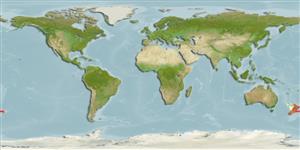Holocéfalos (quimeras) (chimaeras) >
Chimaeriformes (Chimaeras) >
Chimaeridae (Shortnose chimaeras or ratfishes)
Etymology: Hydrolagus: hydro-, combining form of hydor (Gr.), water; lagos (Gr.), hare, i.e., “water rabbit,” probably referring to three pairs of tooth plates, which tend to protrude from the mouth like a rabbit’s incisors. (See ETYFish); novaezealandiae: novus (L.), new, i.e., of New Zealand, in whose waters it occurs. (See ETYFish).
More on author: Fowler.
Environment: milieu / climate zone / depth range / distribution range
Ecología
marino batidemersal; rango de profundidad 25 - 950 m (Ref. 26346), usually 100 - 600 m (Ref. 89422). Deep-water; 34°S - 47°S
Southwest Pacific: endemic to New Zealand.
Tamaño / Peso / Age
Maturity: Lm ? range ? - ? cm
Max length : 96.0 cm TL macho / no sexado; (Ref. 26346); common length : 55.0 cm TL macho / no sexado; (Ref. 9258)
Short description
Morfología | Morfometría
Espinas anales 0; Radios blandos anales: 0. Dark grey dorsally, with silver-white markings, pale silver-grey ventrally (Ref. 26346).
Inhabits the outer continental shelf and upper slope (Ref. 26346). Feeds on crustaceans, shellfish, worms and small fish (Ref. 26346). Maximum length 87 cm without tail filament (Ref. 26346), assumed to have 96 cm TL. Marketed as fillets (Ref. 26346).
Life cycle and mating behavior
Madurez | Reproducción | Puesta | Huevos | Fecundidad | Larva
Oviparous, young hatch from egg case at about 9-12 cm (Ref. 26346).
Cox, G. and M. Francis, 1997. Sharks and rays of New Zealand. Canterbury Univ. Press, Univ. of Canterbury. 68 p. (Ref. 26346)
IUCN Red List Status (Ref. 130435)
Threat to humans
Harmless
Human uses
Pesquerías: escaso valor comercial
Más información
ReferenciasAcuiculturaPerfil de acuiculturaRazasGenéticaElectrophoresesheritabilidadEnfermedadesProcesamientoNutrientsMass conversion
Herramientas
Special reports
Download XML
Fuentes de Internet
Estimates based on models
Preferred temperature (Ref.
123201): 8 - 13.7, mean 10.8 °C (based on 62 cells).
Phylogenetic diversity index (Ref.
82804): PD
50 = 0.5000 [Uniqueness, from 0.5 = low to 2.0 = high].
Bayesian length-weight: a=0.00240 (0.00122 - 0.00472), b=3.14 (2.96 - 3.32), in cm total length, based on LWR estimates for this species & (Sub)family-body (Ref.
93245).
Nivel trófico (Ref.
69278): 3.5 ±0.46 se; based on food items.
Resiliencia (Ref.
120179): Bajo, población duplicada en un tiempo mínimo de 4.5-14 años (Assuming Fec <100).
Prior r = 0.28, 95% CL = 0.16 - 0.49, Based on 1 stock assessment.
Fishing Vulnerability (Ref.
59153): High vulnerability (58 of 100).
Climate Vulnerability (Ref.
125649): Very high vulnerability (76 of 100).
Nutrients (Ref.
124155): Calcium = 11.4 [3.1, 38.0] mg/100g; Iron = 0.389 [0.134, 0.967] mg/100g; Protein = 15.9 [10.4, 19.0] %; Omega3 = 0.266 [0.100, 0.709] g/100g; Selenium = 18 [5, 59] μg/100g; VitaminA = 6.22 [1.30, 27.04] μg/100g; Zinc = 0.326 [0.172, 0.627] mg/100g (wet weight);
